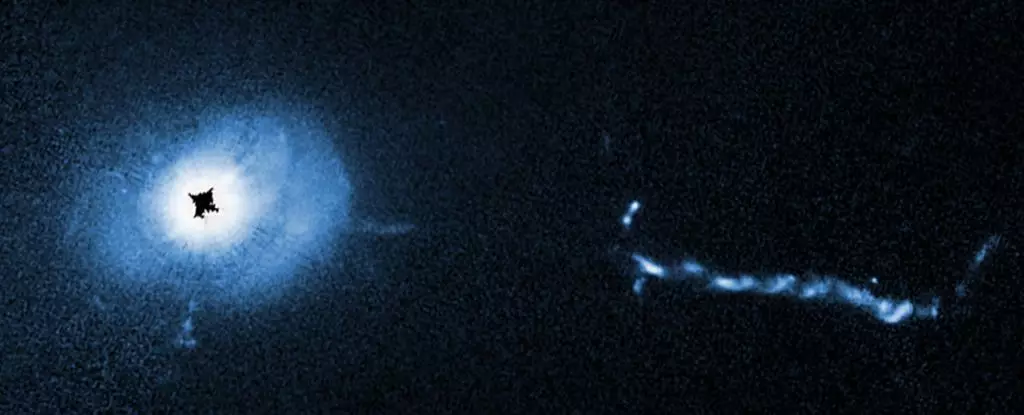In the expansive universe, quasars represent some of the most enigmatic and brilliant phenomena observable from Earth. Among them, 3C 273 stands out as a remarkable subject for study due to its proximity—approximately 2.5 billion light-years away—and its extraordinary luminescence. Recently, astronomers harnessed the powerful capabilities of the Hubble Space Telescope to delve deeper into the structures and characteristics of this quasar, piecing together clues that may illuminate the mechanisms powering such celestial bodies.
Quasars, or quasi-stellar objects, are powered by supermassive black holes residing at the cores of their parent galaxies. These black holes, while themselves dark and unobservable, create a distinctive spectacle through the accretion of surrounding gas and dust. This matter spirals into the black hole, forming an accretion disk where the intense gravitational forces and friction generate extreme heat, resulting in an outpouring of brilliant light. 3C 273, though not the closest quasar to our planet, emits a luminosity equivalent to trillions of suns packed into a minuscule galactic region, rendering it visible even with basic telescopic equipment.
Recent observations of 3C 273 have unearthed valuable data that enhance our understanding of quasar behavior, paving the path for enhanced models in cosmic formation and evolution. This study marks a significant achievement for the scientific community, exhibiting not just the observational prowess of Hubble, but also a novel technique that holds the promise of greater insight into the quasar phenomenon itself.
A Breakthrough with Hubble’s Advanced Technology
The latest observations were achieved using the Space Telescope Imaging Spectrograph (STIS), which ingeniously employed a makeshift coronagraph to obscure the overwhelming brilliance of the quasar. This technique is akin to shielding one’s eyes from a glaring flashlight, thus allowing for the assessment of the structures adjacent to the intense luminosity of the quasar. By blocking the overpowering light, astronomers revealed intricate details that had previously eluded them. This leap in observational capability has led to groundbreaking findings, revealing features and structures within a radius of 16,000 light-years of the quasar’s core.
The results of the Hubble survey were nothing short of astounding, identifying a variety of unexpected formations—a testament to the complexity and dynamism of cosmic structures. The data showed potential remnants of satellite galaxies or material caught in the gravitational grasp of the quasar, as well as the emergence of a new core jet and a perplexing L-shaped filament that awaits further exploration.
One of the most profound discoveries made through the latest observation is the measurement of the astrophysical jet that originates from the black hole’s magnetic field. This jet extends an impressive 300,000 light-years into the abyss of intergalactic space and has been extensively tracked over a period of 22 years. Strikingly, the findings suggest that the velocity of this jet accelerates as it ventures farther from its source, prompting questions about the forces driving this motion and their implications for our understanding of jet dynamics.
The data gathered signifies a bridge between previously fragmented understandings of quasar morphology. By integrating insights from both sub-scale radio interferometry and large-scale optical imagery, researchers are outfitting themselves with a more holistic view of the sprawling environments encasing quasars.
The Future of Quasar Research
As astronomers continue to dissect the complexities revealed in the 3C 273 observations, the quest to comprehend quasars has undergone a transformative shift. The newfound clarity of detail presents an unparalleled opportunity for the implementation of analytical models that may decode the multifaceted interactions governing galaxies and their cores over time.
As noted by astronomer Bin Ren, this research provides a refreshing perspective on the intricate interplay between quasars and their host galaxies. By transcending previous limitations in observational technology, Hubble has gifted researchers an unprecedented avenue to refine and expand their understanding of cosmic morphology.
The study of quasars remains one of the most exhilarating frontiers in modern astrophysics. With new techniques and observatory advancements, astronomers are poised to make groundbreaking discoveries that could redefine our understanding of the universe. The progress seen with 3C 273 serves as a beacon of hope for revealing the mysteries of quasars, suggesting that there is still much to learn about the powerful forces that rule the cosmos. As research evolves, so too will our understanding of these luminous giants and their role in galactic formation and evolution.


Leave a Reply